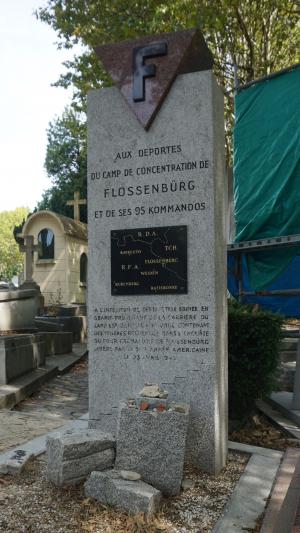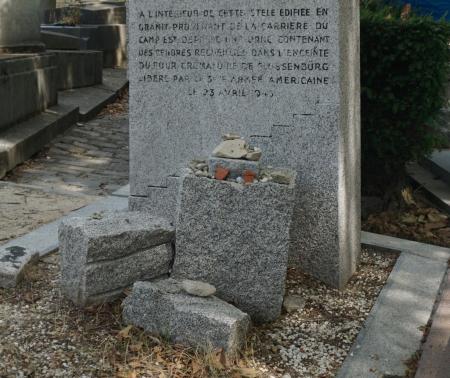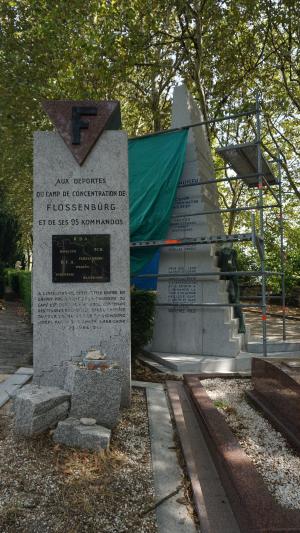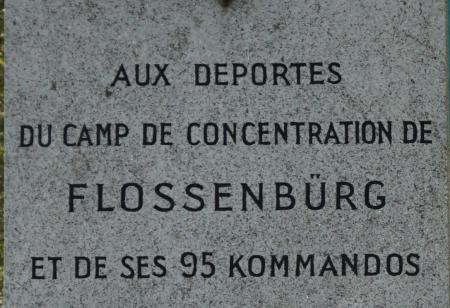Obj. ID: 53314
Jewish Funerary Art Flossenburg Camp Monument in the Père Lachaise Cemetery in Paris, France, 1953
To the main object: Jewish tombstones at Père Lachaise Cemetery in Paris, France

Name of Monument
Flossenbürg Concentration Camp Monument at Pere Lachaise Cemetery
Who/What is Commemorated?
Victims of the Flossenbürg Concentration Camp
Description:
The monument is at the edge of section 97 of the cemetery, in an area of other collective monuments. It is one of more than a dozen memorials erected in the past 70 years commemorating victims of various Nazi concentration and death camps.
The memorial occupies of narrow rectangular plot outlines with smooth-cut grey granite border stones. The area within is covered in dirt and small pebbles. In this, the memorial plot looks like a typical cemetery gravesite. At the far end rises a tall rectangular grey granite stele culminating in a triangular polished red granite cut stone set into the top of the stele, point facing down. A large “F” cut in black stone is set on the face of the red triangle referring to triangle badges used in camps for identification, where F stood for French and red for political inmates.
The face os the stele is divided into three fields. The center field is an attached polished black granite plaque with a map showing the location of Fossenbürg. Above this is large letter is the dedicatory inscription to those deported to Flossenbürg and its 95 sub-camps. Below the map is an inscription indicating that ashes from the crematorium at the camp are included in the memorial, and that the granite used comes from the quarry at the camp. Beneath this inscription inscribed in profile is a pattern showing steps – presumably the steps in the granite quarry.
In front of the stele, set on the ground, are four partially worked blocks of granite form the Flossenbürg quarry, where prisoners labored under terrible conditions.
Inscriptions
AUX DEPORTES
DU CAMP DE CONCENTRATION DE
FLOSSENBÜRG
ET DE SES 95 KOMMANDOS
A L’INTERIOIEUR DE CETTE STELE EDIFEE EN
GRANIT PROVI NANT DE LA CARRIERE DU
CAMP EST DEPOSEE URNE CONTENANT
DES CENDRES RECUEILLILE DANS L’ENCEINTE
DU FOUR CREMATOIRE DE FLOSSENBURG
LIBERE PAR 3EME ARMEE AMERICAINE
LE 23 AVRIL 1945
Translation: Inside this stele built in granite from the quarry of the camp is deposited an urn containing
ashes collected in the area from the Flossenburg crematory oven, liberated by 3rd American Army, April 23, 1945
Commissioned by
Flossenbürg camp survivors
sub-set tree:
| Père Lachaise Cemetery, section 77, intersection of Av. Transversale #3 and Av. Circolaire
The monument is in section 97 of the cemetery in an area of other collective monuments. It is one of more than a dozen memorials erected in the past 70 years commemorating victims of various Nazi concentration and death camps. These monuments have been erected by camp survivors, political organizations, and other associations beginning in 1949, when memorials to victims of Auschwitz-Birkenau (June) and the camp at Neuengamme (November) were dedicated. The Flossenbürg memorial was dedicated by camp survivors with embedded ashes from the camp in 1953. It was rededicated in 2004 as part fo the celebration fo the 50th anniversary of the Liberation of Paris.
From Wikipedia:
“Flossenbürg was a Nazi concentration camp built in May 1938 by the SS Main Economic and Administrative Office. Unlike other concentration camps, it was located in a remote area, in the Fichtel Mountains of Bavaria, adjacent to the town of Flossenbürg and near the German border with Czechoslovakia. The camp's initial purpose was to exploit the forced labor of prisoners for the production of granite for Nazi architecture. In 1943, the bulk of prisoners switched to producing Messerschmitt Bf 109 fighter planes and other armaments for Germany's war effort. Although originally intended for "criminal" and "asocial" prisoners, after Germany's invasion of the Soviet Union, the camp's numbers swelled with political prisoners from outside Germany. It also developed an extensive subcamp system that eventually outgrew the main camp. Before it was liberated by the United States Army in April 1945, 89,964 to 100,000 prisoners passed through Flossenbürg and its subcamps. Around 30,000 died from malnutrition, overwork, executions, or during the death marches. Some of those responsible for these deaths, including administrators, guards, and others, were tried and convicted in the Flossenbürg trial. The camp was repurposed for other uses before the opening of a memorial and museum in 2007.”
"Flossenbürg concentration camp,"
Wikipedia, https://en.wikipedia.org/wiki/Flossenbürg_concentration_camp.
Memorial Map, Flossenbürg Concentration Camp Memorial, https://www.gedenkstaette-flossenbuerg.de/en/research/memorial-map (accessed April 7, 2024)









